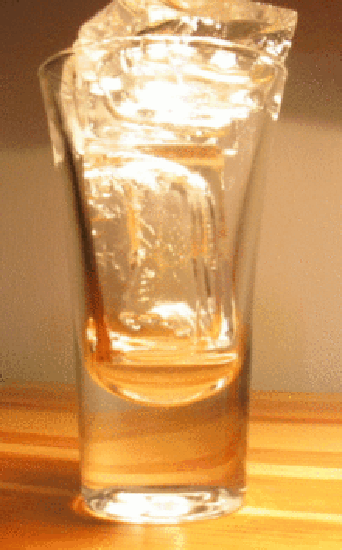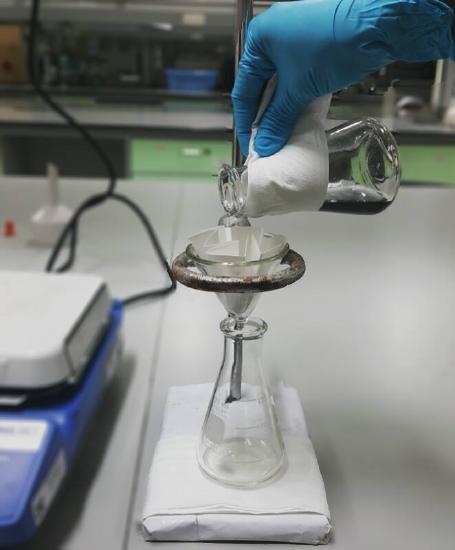which scenarios are examples of physical changes? check all that apply.
3.6: Changes in Matter - Physical and Chemic Changes
- Page ID
- 47460
Learning Objectives
- Characterization a modify equally chemical or concrete.
- List evidence that can indicate a chemical modify occurred.
Change is happening all around us all of the fourth dimension. Just every bit chemists have classified elements and compounds, they have also classified types of changes. Changes are classified as either physical or chemical changes. Chemists learn a lot about the nature of thing by studying the changes that thing can undergo. Chemists make a distinction between two different types of changes that they study—physical changes and chemical changes.
Physical Change
Concrete changes are changes in which no bonds are broken or formed. This means that the same types of compounds or elements that were there at the beginning of the change are there at the terminate of the change. Because the ending materials are the same equally the beginning materials, the backdrop (such as color, boiling signal, etc.) will likewise be the same. Physical changes involve moving molecules effectually, but not irresolute them. Some types of physical changes include:
- Changes of state (changes from a solid to a liquid or a gas and vice versa).
- Separation of a mixture.
- Physical deformation (cutting, denting, stretching).
- Making solutions (special kinds of mixtures).
As an ice cube melts, its shape changes as it acquires the ability to menstruum. However, its limerick does not change. Melting is an instance of a concrete modify. A physical modify is a change to a sample of matter in which some properties of the material change, but the identity of the matter does not. When liquid h2o is heated, it changes to water vapor. However, even though the physical backdrop have inverse, the molecules are exactly the same as before. We withal have each water molecule containing two hydrogen atoms and one oxygen cantlet covalently bonded. When you lot have a jar containing a mixture of pennies and nickels and y'all sort the mixture so that you have 1 pile of pennies and another pile of nickels, you accept non contradistinct the identity of the pennies or the nickels—you've simply separated them into two groups. This would exist an example of a physical change. Similarly, if yous take a slice of newspaper, you don't change it into something other than a slice of paper by ripping it up. What was newspaper earlier you started tearing is still paper when you are washed. Again, this is an example of a physical modify.

Physical changes can further be classified as reversible or irreversible. The melted ice cube may be refrozen, so melting is a reversible physical change. Concrete changes that involve a change of state are all reversible. Other changes of country include vaporization (liquid to gas), freezing (liquid to solid), and condensation (gas to liquid). Dissolving is too a reversible physical change. When salt is dissolved into water, the salt is said to have entered the aqueous state. The common salt may be regained by boiling off the water, leaving the salt behind.
Chemical Modify
Chemical changes occur when bonds are broken and/or formed between molecules or atoms. This means that one substance with a sure set of properties (such as melting point, color, taste, etc) is turned into a different substance with different properties. Chemical changes are oft harder to reverse than concrete changes.
I good example of a chemical alter is called-for a candle. The human action of burning paper really results in the formation of new chemicals (carbon dioxide and water) from the burning of the wax. Some other example of a chemical modify is what occurs when natural gas is burned in your furnace. This time, on the left there is a molecule of methane, \(\ce{CH_4}\), and two molecules of oxygen, \(\ce{O_2}\); on the right are two molecules of water, \(\ce{H_2O}\), and 1 molecule of carbon dioxide, \(\ce{CO_2}\). In this case, non just has the appearance changed, but the structure of the molecules has also inverse. The new substances practice not have the aforementioned chemical properties as the original ones. Therefore, this is a chemical change.

We can't actually run across molecules breaking and forming bonds, although that'south what defines chemical changes. We accept to brand other observations to point that a chemic alter has happened. Some of the evidence for chemical change will involve the energy changes that occur in chemic changes, but some bear witness involves the fact that new substances with different properties are formed in a chemic change.
Observations that help to betoken chemic change include:
- Temperature changes (either the temperature increases or decreases).
- Light given off.
- Unexpected color changes (a substance with a dissimilar color is fabricated, rather than just mixing the original colors together).
- Bubbles are formed (but the substance is not boiling—y'all made a substance that is a gas at the temperature of the starting time materials, instead of a liquid).
- Dissimilar odor or taste (practise not taste your chemistry experiments, though!).
- A solid forms if two clear liquids are mixed (look for floaties—technically called a precipitate).
Example \(\PageIndex{1}\)
Label each of the following changes equally a physical or chemical change. Requite evidence to back up your answer.
- Boiling h2o.
- A nail rusting.
- A green solution and colorless solution are mixed. The resulting mixture is a solution with a pale green color.
- Two colorless solutions are mixed. The resulting mixture has a xanthous precipitate.
Solution
- Physical: boiling and melting are physical changes. When water boils, no bonds are broken or formed. The change could be written: \(\ce{H_2O} \left( fifty \right) \rightarrow \ce{H_2O} \left( g \right)\)
- Chemic: The nighttime grey nail changes color to form an orange flaky substance (the rust); this must exist a chemic modify. Colour changes indicate chemical change. The following reaction occurs: \(\ce{Fe} + \ce{O_2} \rightarrow \ce{Fe_2O_3}\)
- Concrete: considering none of the properties changed, this is a physical change. The light-green mixture is still light-green and the colorless solution is nonetheless colorless. They have but been spread together. No colour modify occurred or other evidence of chemical change.
- Chemical: the formation of a precipitate and the color change from colorless to yellow indicate a chemical modify.
Practise \(\PageIndex{i}\)
Label each of the following changes as a physical or chemical change.
- A mirror is broken.
- An atomic number 26 nail corroded in moist air
- Copper metallic is melted.
- A catalytic converter changes nitrogen dioxide to nitrogen gas and oxygen gas.
- Answer a:
- concrete change
- Reply b:
- chemical change
- Respond c:
- physical change
- Respond d:
- chemical modify
Separating Mixtures Through Physical Changes
Homogeneous mixtures (solutions) tin exist separated into their component substances by physical processes that rely on differences in some physical property, such as differences in their boiling points. Two of these separation methods are distillation and crystallization. Distillation makes employ of differences in volatility, a mensurate of how easily a substance is converted to a gas at a given temperature. A elementary distillation apparatus for separating a mixture of substances, at least one of which is a liquid. The most volatile component boils first and is condensed back to a liquid in the water-cooled condenser, from which it flows into the receiving flask. If a solution of salt and water is distilled, for example, the more volatile component, pure water, collects in the receiving flask, while the salt remains in the distillation flask.

Mixtures of two or more liquids with dissimilar boiling points tin be separated with a more than circuitous distillation apparatus. 1 example is the refining of crude petroleum into a range of useful products: aviation fuel, gasoline, kerosene, diesel fuel, and lubricating oil (in the guess order of decreasing volatility). Another example is the distillation of alcoholic spirits such equally brandy or whiskey. This relatively unproblematic procedure caused more than a few headaches for federal authorities in the 1920s during the era of Prohibition, when illegal stills proliferated in remote regions of the United States.
Another case for using concrete properties to separate mixtures is filtration (Figure \(\PageIndex{four}\)). Filtration is any mechanical, physical or biological operation that separates solids from fluids (liquids or gases) by calculation a medium through which only the fluid can pass. The fluid that passes through is called the filtrate. There are many unlike methods of filtration; all aim to attain the separation of substances. Separation is achieved past some grade of interaction between the substance or objects to be removed and the filter. The substance that is to pass through the filter must be a fluid, i.e. a liquid or gas. Methods of filtration vary depending on the location of the targeted material, i.e. whether it is dissolved in the fluid stage or suspended as a solid.

Summary
- Chemists make a distinction between two different types of changes that they study—physical changes and chemical changes.
- Concrete changes are changes that do not modify the identity of a substance.
- Chemical changes are changes that occur when one substance is turned into some other substance.
- Chemical changes are oft harder to reverse than physical changes. Observations that indicate a chemical change has occurred include color change, temperature change, light given off, formation of bubbles, formation of a precipitate, etc.
Contributions & Attributions
This page was constructed from content via the following contributor(s) and edited (topically or extensively) past the LibreTexts development team to encounter platform style, presentation, and quality:
-
CK-12 Foundation by Sharon Bewick, Richard Parsons, Therese Forsythe, Shonna Robinson, and Jean Dupon.
-
Boundless (www.boundless.com)
-
Marisa Alviar-Agnew (Sacramento Urban center College)
-
Henry Agnew (UC Davis)
Source: https://chem.libretexts.org/Bookshelves/Introductory_Chemistry/Map%3A_Introductory_Chemistry_(Tro)/03%3A_Matter_and_Energy/3.06%3A_Changes_in_Matter_-_Physical_and_Chemical_Changes
Posted by: baderevich1941.blogspot.com


0 Response to "which scenarios are examples of physical changes? check all that apply."
Post a Comment